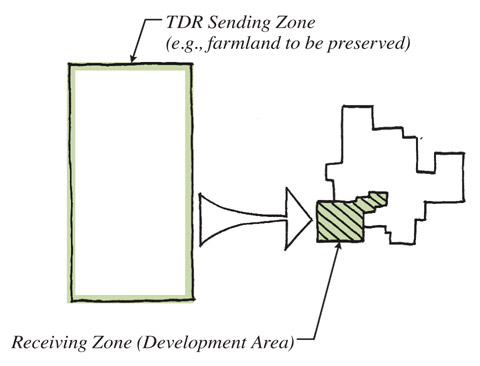|
|
Open Space Protection Tools
Inasmuch as there is a variety of open spaces in the region, there is a variety of protection methods. These include Transfer of Development Rights, Purchase of Development Rights, Conservation Easements, and Conservation Planning. Refer to Critical Design Practices: Conservation Planning for specifics on the latter technique.
|
|
Transfer of Development Rights (TDR)
Transfer of Development Rights provides local jurisdictions a regulatory tool to redirect development from open space to areas more conducive to development. TDR programs alter development patterns in a community: sending development from one area to another. As with PDR programs, a landowner receives financial compensation for the development rights of a parcel; however, with TDR programs, the development rights are shifted (i.e., transferred) to another area within the community. TDR programs offer communities a method for directing development to those areas most appropriate for it. Refer to State of Michigan Public Act 228 of 2003 for specifics.
|
|
|

|
|
Purchase of Development Rights (PDR)
Purchase of Development Rights is a voluntary program where landowners receive financial compensation for selling a parcel’s development rights to a land trust or similar agency. In return for the development value, a deed restriction is placed on a portion or entire piece of property protecting the land from future development. PDR programs provide land owners capital and ensure the protection of open spaces for future generations.
|
|
 |
Conservation Easements
A conservation easement – also known as an agricultural preservation easement, historic preservation easement, scenic easement, or forever wild easement – is a legally binding agreement (i.e., deed restriction) between a property owner and a land trust. While individuals retain ownership of their property, an easement restricts the development of the property. In return for the donated or sold development rights, a land trust agrees to ensure the terms of the conservation easement are followed through monitoring the parcel, enforcing the easement’s terms, and long-term stewardship. Easements are drafted to meet the specific needs of a property owner while adhering to the minimum requirements of a land trust. All donations are voluntary; nonetheless, since most land trusts are non-profit, donations frequently qualify as tax deductions. The income tax and property tax benefits many property owners receive provide an additional enticement to establish a conservation easement. Although land trusts can preserve land through leasing of property, management agreements, and mutual covenants, conservation easements provide the greatest protection for conservation.
|
|
|
Key Points:
- Transfer of Development Rights redirects development from a sending zone (i.e., area to be protected) to a receiving zone (i.e., areas suited for development). This allows communities to protect farmland or other open spaces while directing development to the most appropriate areas.
- Purchase of Development Rights removes the potential for development from a parcel of land in exchange for financial compensation to the land owner.
- A Conservation Easement is a voluntary agreement between a land owner and a land trust or conservancy to restrict development on all or a portion of the property. Property owners can receive income tax and property tax benefits for donating or selling conservation easements.
|
|
